Top>Research>Unknown Damage from the Earthquake
 Index
Index
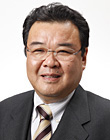
Hirokazu Hirano [profile]
Education Course
Unknown Damage from the Earthquake
-Preparing for the Nankai Trough-
Hirokazu Hirano
Professor of Structural Engineering, Seismic Engineering and Environmental Simulation,
Director of Computer Center, Faculty of Policy Studies, Chuo University
1. Introduction
Slightly more than 2 years and 7 months have passed since the Great East Japan Earthquake (Tohoku Pacific Coast Earthquake (M9.0)) struck on March 11th, 2011. During this time, many issues have been raised regarding tsunamis and nuclear power. However, were the tsunami and nuclear accident the only causes of this massive disaster? In autumn 2012, the Japanese government issued a new disaster estimate for a major earthquake originating from the Nankai Trough along the Pacific coast of Japan. According to this estimate, such an earthquake would claim as many as 323,000 lives and destroy 2.4 million buildings. Such a disaster can truly be called national crisis.
The estimate describes the occurrence of longer-period ground motion. Even the Metropolitan area, located far away from the epicenter, would experience a slow tremor for a long period of time. In this article, I will examine damage thought to have been caused by a longer-period ground motion during the Great East Japan Earthquake. I will attempt to verify any damage which was overlooked or unknown.
2. Differences in damage caused by ground motion and periods
| Name | Period |
|---|---|
| Extremely | 0.5 second or less |
| Short-period | 0.5 to 1.0 second |
| Shorter-period | 1.0 to 2.0 seconds |
| Longer-period | 2.0 to 5.0 seconds |
| Long-period | 5.0 seconds or more |
Figure 1 shows the relationship between periods[1] and the names of ground motion used in seismic engineering. Normally, damage caused by an earthquake is discussed in terms of magnitude, which represents the scale of the earthquake, and seismic intensity, which represents the strength of tremors. At this point, I would like to introduce my findings when I participated in a group survey of the Kanto region (7 prefectures of the Kanto region, Niigata Prefecture and Yamanashi Prefecture) as part of fieldwork on the Great East Japan Earthquake performed by the Kanto Branch of Japan Society of Civil Engineers. This survey showed that, other than ground liquefaction and tsunami, damage to civil engineering structures was small compared to the scales of the quake. In particular, the only bridge which fell due to the earthquake was Rokko-Ohashi Bridge in Ibaraki Prefecture. These findings demonstrate that disaster is not caused only by earthquake tremors striking the city. Instead, disaster occurs when our lives are threatened by buildings that are destroyed by the earthquake.
The term structure is a general name for buildings, roads, bridges, storage tanks, etc. These structures possess certain periods prone to swaying when vibration is caused by earthquake tremors. These are known as natural periods and are unique to each structure. For example, buildings are modeled as a pendulum which is secured to the ground. A longer pendulum (in other words, a taller building) results in a longer time for these natural periods. Another example is large suspension bridges such as Rainbow Bridge and large cable-stayed bridges such as Yokohama Bay Bridge. A longer span length of these bridges results in a longer natural period. Similarly, in the case of storage tanks for oil or other fluids, the greater the diameter, the longer the natural period.
An example of impact by these periods is the small amount of damage suffered in the area around Kurikoma City, Miyagi Prefecture despite a seismic intensity of 7 during the Great East Japan Earthquake. Similarly, other areas experienced relatively little damage despite a seismic intensity of 6-plus. The reason is that these areas are located close to the epicenter and there was an extremely short period for ground motion, not because the buildings possessed sufficient seismic resistance. Generally speaking, extremely short-period ground motion (0.5 second or less) accompanying a seismic intensity of 6-lower has little effect on old wooden homes. However, even at the same seismic intensity of 6-lower, the possibility of such homes collapsing increases dramatically in the case of shorter-period ground motion (1.0 to 2.0 seconds). This is because the natural period of old wooden homes is in the shorter-period ground motion. An example of this is the collapse of many old wooden homes during the Southern Hyogo Earthquake in 1995. Conversely, in the case of skyscrapers, there is rarely a problem with either extremely short-period ground motion or shorter-period ground motion. Although normal buildings suffer almost no damage due to longer-period ground motion, this period causes skyscrapers to sway violently. People experiencing such swaying will feel as if they were riding in a boat which is being rocked greatly. Although Tokyo is located more than 200 kilometers from the epicenter of the Great East Japan Earthquake and only experienced tremors with seismic intensity of 5-plus, skyscrapers in Shinjuku swayed broadly and slowly for more than 10 minutes. Furthermore, although the Osaka Prefectural Government Sakishima Building (height of 256 meters) is located 600 kilometers from the epicenter, with seismic intensity of 3, people were trapped inside a stopped elevator and there was damage to facilities such as interior materials and fire-prevention doors.
Other damage included the falling of exterior walls from buildings, the collapse of ceilings in wide venues such as gymnasiums and auditoriums, and overflowing of oil storage tanks, nuclear fuel storage pools and other tanks due to sloshing in which fluid within the tanks was excited into waves.
Moreover, if the earthquake area is a large plain or basin, the longer-period ground motion and long-period ground motion which have spread are amplified and enhanced by the sediment which is directly under the large plain or basin. The width of the tremors is large and there is a long ground motion when shaking. Structurally speaking, plains and basins sometimes have the tertiary conditions for occurrence of earthquakes. There is concern regarding damage in sedimentary basins such as the Kanto Plain, the Osaka Plan and the Nobi Plain.
- ^ A period is the time required for the ground motion to complete on back-and-forth motion
3. Was there any unknown earthquake damage?
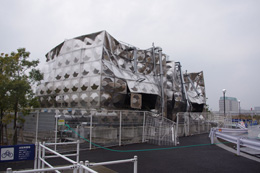
Photograph 1: Damage to large stainless steel panel tank (Natori City, Miyagi Prefecture)
Following the Great East Japan Earthquake, my colleagues and I conducted a survey of storage tanks other than oil tanks. For example, we surveyed large containers such as facilities for water supply, water treatment facilities and facilities for storing nuclear fuel. In particular, we focused on damage caused by destruction of tanks themselves or by the overflowing of liquid contained in rectangular tanks during the earthquake. An example of large-scale damage is the destruction of the large stainless steel panel tank for water supply in Natori City, Miyagi Prefecture (see Photograph 1).
The survey also revealed that rectangular tanks suffered a large amount of damage. According to a survey of public elementary schools and junior high schools in Sendai City, water tanks were damaged at 62 of the 196 schools, or 32%. Tanks were completely destroyed at 11 of these schools. One example is Sendai City Tomizawa Junior High school, which is located in Taihaku Ward of Sendai City and was designated as a primary evacuation center. The school’s aboveground FRP panel tank was destroyed and water for daily life could no longer be used. As a result, water could not be used for daily hygienic tasks such as washing hands, washing faces and brushing teeth. This created concern regarding the outbreak of infectious diseases. This had a severe impact on the lifestyle of more than 1,200 people taking shelter at the school.
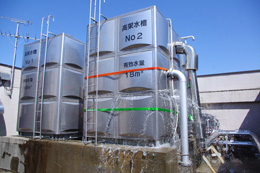
Photograph 2: Damage to elevated tank on the roof of Sendai Medical Center (Sendai City, Miyagi Prefecture)
Photograph 2 shows Sendai Medical Center (formerly Sendai City National Hospital), which serves as a central hospital during disasters. The hospital was forced to close more than 100 patient rooms due to the destruction of an elevated tank. The hospital also restricted the transfer of hospitalized patients and the acceptance of emergency cases. There was not even enough water to wash mud off tsunami victims who were transported to the hospital. The hospital was temporarily unable to function as a central hospital for disasters. Even in Tsukuba City, which was located far from the epicenter, several water tanks were destroyed at the High Energy Accelerator Research Organization. Also, in Tokyo, 8 water tanks were damaged in Edogawa Ward and 1 in Chiyoda Ward at public facilities alone.
This damage was caused by longer-period ground motion which resulted in long, slow tremors with a period of 2 to 5 seconds. This ground motion caused skyscrapers in Shinjuku to sway slowly during the earthquake. These long, slow tremors also caused a sloshing phenomenon. During the 2003 Tokachi-Oki Earthquake, sloshing caused a tank fire at an oil refinery in Tomakomai City. Sloshing was also responsible for overflow of a spent nuclear fuel pool at Kashiwazakikariwa Nuclear Power Station during the 2007 Chuetsu-Oki Earthquake.
4. Investigating causes and formulating future response
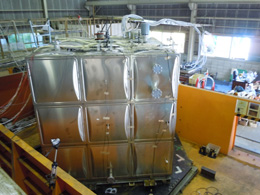
Photograph 3 Stainless steel panel tank (installed on large shaking table at Aichi Institute of Technology))
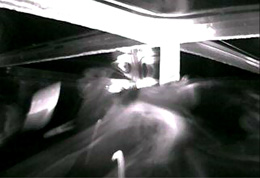
Photograph 4 Conditions inside tank
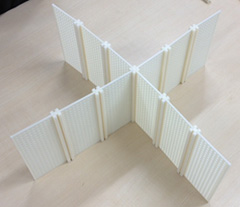
Photograph 5 Floating-type vibration-control device (made from resin)
Why did water tanks suffer such severe damage? In order to answer this question, a joint industry-academia research group was formed. From summer 2012, the group used the shaking table at Chuo University and the large shaking table at Aichi Institute of Technology to conduct a vibration experiment using the 3m×3m×3m stainless steel panel tank shown in Photograph 3. The tank was filled with 25 tons of water and exposed to tremors equivalent to a seismic intensity of 3. The sound of water striking the ceiling of the tank could be heard from approximately 1 minute after shaking began. Furthermore, the tank continued to vibrate for more than 10 minutes after the shaking was stopped. Photograph 4 shows conditions inside the tank. It is apparent that the water had been excited into waves. During the Great East Japan Earthquake, it can be deduced that the force of such waves acted upon the ceiling and sides of tanks. This resulted in damage to welded components, causing leaks and destroying tanks.
In the next phase of joint research, we proposed a vibration-control device to prevent sloshing. Specifically, we suppressed the sloshing of waves by installing a cross-shaped net inside the tank. This net quickly reduced sloshing by creating water resistance when water passed through the net. As a result of this experiment, height of the waves could be lowered to one third. Furthermore, in 2013, we proposed a new floating-type vibration-control device (see Photograph 5) opposed to conventional fixed-type devices. Moreover, since water tanks are used to store drinking water, we introduced vibration-control devices made from resin to ensure chlorine resistance. Merits of floating-type vibration-control devices include continued functionality when the water depth changes and ease of installation in existing water tanks.
5. Conclusion
People living in the Metropolitan area may believe that a major earthquake occurring in the Nankai Trough will have little effect on them. However, the effect of longer-period ground motion creates the high possibility of damage even when an earthquake occurs far away. The reason why longer-period ground motion has such a substantial effect is a complicated combination of conditions such as ground conditions and natural periods possessed by structures. Accordingly, it is necessary to examine each structure in advance and implement appropriate measures. The water tanks discussed in this article are always installed at hospitals, schools and other facilities which serve as evacuation centers in the event of a disaster. This makes water tanks important structures as lifelines. Unavailability of water will shut down the lifeline and have a major impact on the entire disaster area. Therefore, as part of disaster preparedness, it is necessary to implement vibration-control measures to prevent sloshing in water tanks. This will lead to disaster prevention.
The research introduced in this article is funded by Grants-in-Aid for Scientific Research (Scientific Research (B); Head Researcher: Hirokazu Hirano) from the Japan Society for the Promotion of Science and the Adaptable and Seamless Technology Transfer Program (A-STEP) of the Japan Science and Technology Agency. A joint industrial-academic application has already been filed to designate research results as a patent of Chuo University. Funds received for this research are currently being used to construct a new shaking table in the Seismic Resistance Experiment Center at Aichi Institute of Technology. Scheduled for completion in November 2013, this shaking table will be capable of producing large acceleration and displacement. The new shaking table will be used to conduct further experiments and research.
- Hirokazu Hirano
Professor of Structural Engineering, Seismic Engineering and Environmental Simulation,
Director of Computer Center, Faculty of Policy Studies, Chuo University - Born in Tokyo in 1955. Graduated from the Department of Civil Engineering (currently the Department of Civil and Environmental Engineering) in the Faculty of Science and Engineering, Chuo University in 1979. After completing the Master’s Program in civil engineering in the Graduate School of Science and Engineering, Chuo University, entered employment at Mitsui Engineering & Shipbuilding Co., Ltd. Served as a part-time lecturer in the Faculty of Science and Engineering, Chuo University and as a full-time instructor/assistant professor in the Faculty of Policy Studies before becoming Professor at Chuo University in 1998. From November 2009 to October 2011, served as Dean of the Graduate School of Policy Studies, Chuo University. Holds a PhD in engineering. In the fields of experiments and numerical analysis, conducts research in preventing the swaying of structures due to factors such as wind or earthquakes. In addition to publishing research papers, has developed various types of vibration-control devices which use simple mechanisms to stop swaying. His devices are used by companies such as the Metropolitan Expressway Company Ltd. Receives his first patent royalties at Chuo University.
- Research Activities as a Member of Research Fellowship for Young Scientists (DC1), Japan Society for the Promotion of Science (JSPS) Shuma Tsurumi
- Important Factors for Innovation in Payment Services Nobuhiko Sugiura
- Beyond the Concepts of Fellow Citizens and Foreigners— To Achieve SDGs Goal 10 “Reduce Inequality Within and Among Countries” Rika Lee
- Diary of Struggles in Cambodia Fumie Fukuoka
- How Can We Measure Learning Ability?
—Analysis of a Competency Self-Assessment Questionnaire— Yu Saito / Yoko Neha - The Making of the Movie Kirakira Megane








